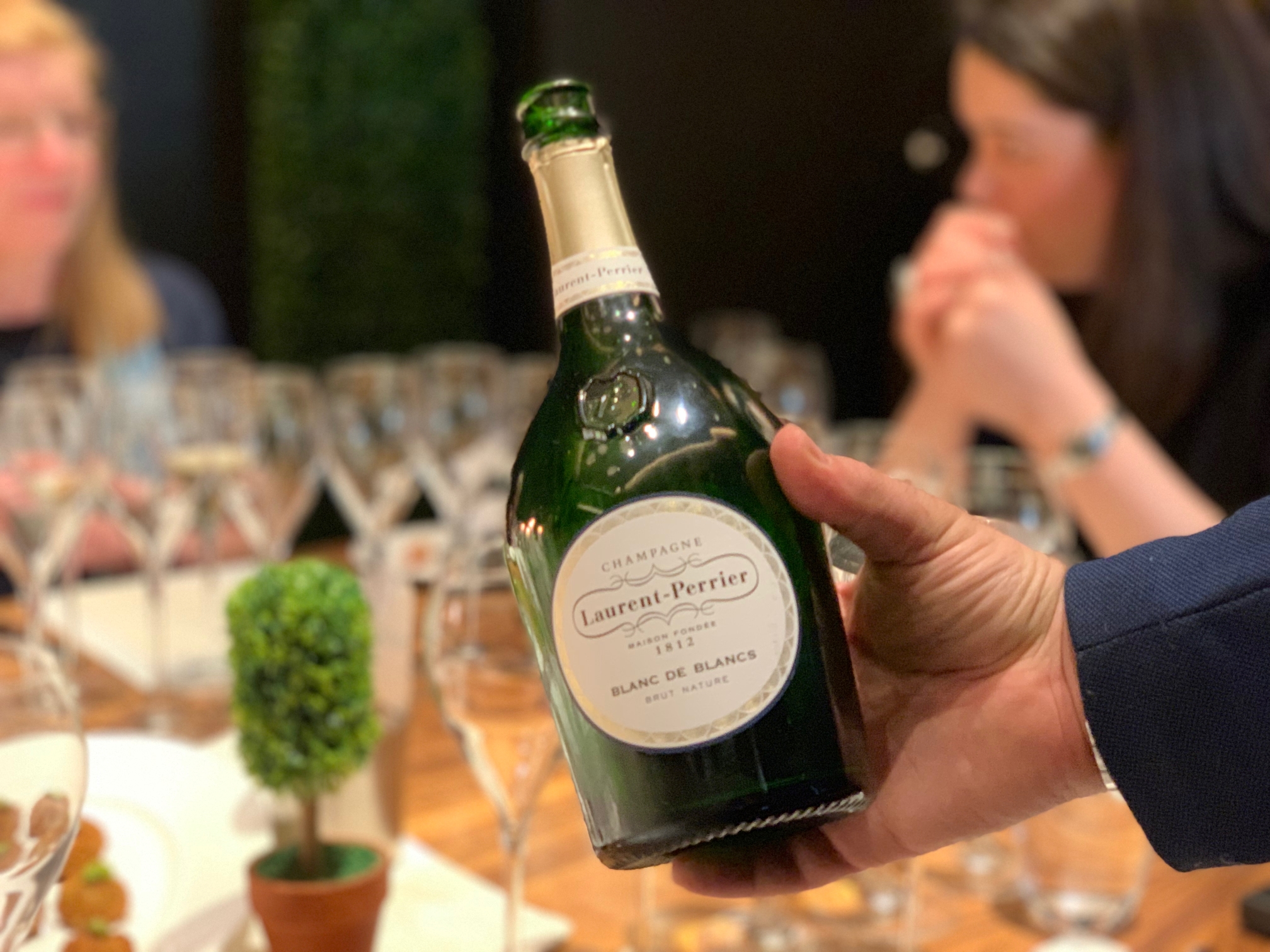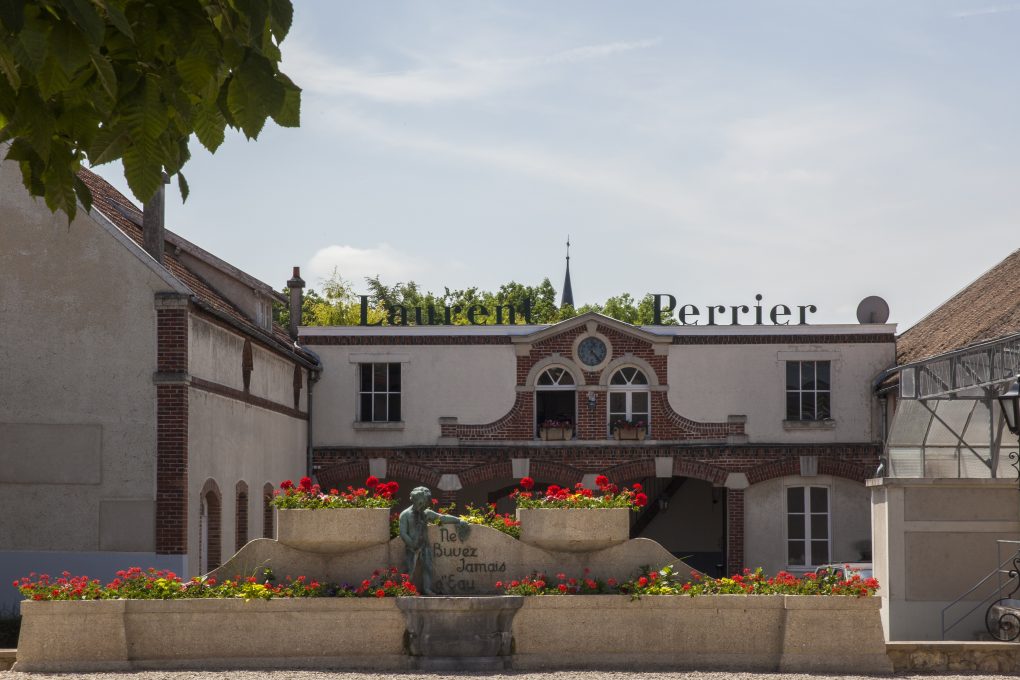Carrie Coolidge is a Pursuitist contributor based in Manhattan. From…

“The spirit of innovation at Laurent-Perrier is still seen today, with the first entirely new cuvee in over 30 years,” exclaimed DeFeo, as she passed around the bottle for everyone to admire.
For Laurent-Perrier, quality comes first, even at the expense of earning higher profits. Something must be working, as the champagne house, which is based in Tours-sur-Marne in Champagne, France, is one of the top selling champagne brands in the world.
Take the Blanc de Blancs Brut Nature, for example. Indeed, the first new cuvée launched by the 207-year-old Champagne house in more than three decades, it is entirely made with chardonnay grapes, which are far more expensive than the other varieties in the region. Incredibly, the chardonnay grape is the least planted and most expensive grape in the entire Champagne region.
Laurent-Perrier’s grapes are from several of the best crus in the region, including some Chardonnay vineyards it purchased in 2004 located in crus that yield the ideal maturity and acidity required for an elegant cuvée. The wine is aged for six years before being disgorged with zero dosage; 60% of the blend was harvested in 2012. Not only is the Blanc de Blancs unusual for being a blend of 100% chardonnay with zero added sugar, but it also shares the same iconic bottle shape as Laurent-Perrier’s Cuvée Rosé.
This Brut Nature aligns with the innovation of the company in the non-dosage champagne category, which they pioneered. While Brut Nature is allowed to have up to 3 grams of residual sugar, with sugar added to kick start the secondary fermentation (but not at the level of dosage), the Laurent-Perrier Blanc de Blancs Brut Nature has zero sugar added to it. “This is my new diet champagne,” says DeFeo. “Because there is no added sugar, it has 65% of the calories of other brut champagne.”
The Blanc de Blanc cuvée will retail for $89.99, but will be available in limited quantity in the U.S. with most of that designated for restaurants. Why a champagne of this extraordinary quality and of such limited supply would be offered at such a moderate price point is easy to understand once you learn about the motives of the house, which is more concerned about quality than profits.
“We have never tried to be the most expensive champagne on the market just to build our image,” explains DeFeo. “We want people to enjoy our champagne and we want to be approachable.”
Laurent-Perrier is family-owned and completely independent and is not run like most other corporations. “Our decisions are based on the quality of the wine and not by its marketability, salability or financial constraints,” DeFeo explains. “As the chardonnay grape is more expensive, nobody would be adding it to their blend if they want to make more money.”
Ageing champagne is also an expensive endeavor. And rather than meet the legal minimum time for ageing of 15 months, Laurent-Perrier chooses to age its champagne much longer—four years in the cellar for La Cuvée, its youngest champagne, while its previous non-vintage brut was aged for three years in the cellar. “We decided to extend it for another year because we liked the expression of the wine after some additional cellar ageing,” says DeFeo.
“Our La Cuvée also has more chardonnay in it than almost any other non-vintage brut made in the region,” says DeFeo. “It has the freshness and finesse that we endeavor to have and is our easy drinking champagne. It is a perfect aperitif, it’s really delicious and very balanced.”
These strategies translate into wines that are of a far better quality and value than that of most of the competition, as they are made by a company that is driven by quality, not by quantity or profitability.
The company’s mission to produce high quality Champagne is also seen in its prestige cuvée. The late Bernard de Nonancourt, whose mother purchased Laurent-Perrier from its namesake owners in 1939, strongly believed in innovation. In fact, it was his idea to launch a multi-vintage prestige cuvée Champagne sixty years ago.
Calling it the Grand Siècle, after the Age of Enlightenment which took place in France during the 17th century (considered one of the greatest centuries of civilization), de Nonancourt broke the widely-held convention that a prestige cuvée had to be a vintage. The design of the Grand Siècle bottles was inspired by the work early 17th century master glassblowers.
Since then, Grand Siècle has continued to be produced by blending three different vintages to create the perfect year although it is always 55% Chardonnay and 45% Pinot Noir with grapes sourced from the finest grand crus.
The vintages selected for the Grand Siècle champagne are done so by its longtime Cellar Master, Michel Fauconnet, who has been at Laurent-Perrier for 45 years. While all offer excellent quality, each bring a complementary expression to the blend: one selected for finesse, a second for freshness and the third for structure.
Photo ©Champagne Laurent-Perrier.
The company’s prestigious cuvée Grand Siècle, which is bound to be highly prized among collectors, will now be numbered according to their blends—five of which we tasted through on that evening in May:
Grand Siècle No. 17 (1995, 1993, 1990 vintages; cellar-aged for 21 years before it was disgorged in early 2017).
Grand Siècle No. 20 (1999, 1997, 1996 vintages; disgorged in late 2017 after 17 years of cellar aging).
Grand Siècle No. 22 (2004, 2002, 1999 vintages with 13 years of cellar aging before disgorgement). While 750 ml offerings of this iteration were previously released in the US, magnums—priced at $400—will launch in fall 2019.
Grand Siècle No. 23 (2006, 2004, 2002 vintages; disgorged in early 2018 after 11 years of cellar aging). This is currently available in the U.S.
Grand Siècle No. 24 (2007, 2006 and 2004 vintages with 11 years of cellar ageing before disgorgement). 750 ml bottles will be released in fall 2019 and priced at $149.99.
Another excellent champagne produced by Laurent-Perrier is its Cuvée Rosé. Launched in 1968, it is a varietal, non-vintage rosé that displays an unrivaled depth and complexity. From a proprietary vinification technique to an unmistakable bottle, the Cuvée Rosé—which celebrated its 50 year anniversary—has become iconic.
Produced in a separate winery solely dedicated to this pink-hued bubbly, the Laurent-Perrier Cuvée Rosé is made with pinot noir from parcels specifically designated for rosé production, carefully selected from grand cru villages.
Once the grapes arrive at the winery, they macerate in tanks cru by cru for 48-72 hours. The free-run juice is then separated and fermented, but Laurent-Perrier takes an extra step: they very lightly press the remaining grapes to capture the full character of the Pinot Noir. This resulting rich yet delicate liquid, once vinified, is blended with the free-run juice, forming the core of Laurent-Perrier’s proprietary maceration process.
After secondary fermentation, the wine rests on its lees for at least five years in the winery’s seven miles of chalky underground caves, interrupted only by the timeless and meticulous process of hand-riddling. The resulting champagne—salmon-pink, luscious and aromatic—shows why this wine has maintained its reputation for half a century.
The rounded bottle it is presented in is beautiful both inside and out and pays homage to those used during the time of King Henry IV. Although not handblown today, the angled glass lip at the top of the neck is a nod to a glassblower’s traditional technique. The bottle also features the House marque etched into the front, reflecting an era before paper labels existed.
When Marie-Louise Lanson de Nonancourt purchased Laurent-Perrier in 1939, it had limited production. Since then, the innovative vision of her descendants (including its current owners, Bernard’s daughters, Alexandra Pereyre de Nonancourt and Stéphanie Meneux de Nonancourt) have grown the business and advanced many ideas that have defined champagne production since the mid-20th century.
While these superlatives may sound impressive, they are not what’s driving the company.
“We don’t need to be the biggest,” says DeFeo. “We just want to be known as the best.”
Carrie Coolidge is a Pursuitist contributor based in Manhattan. From 2009 to 2011, Carrie served as Co-Editor of Luxist, the luxury lifestyle website at AOL where she ran the Luxist Awards, a program that honored the very best in fine living. From 1996 to 2009, Carrie was a Staff Writer at Forbes magazine, where she covered real estate, personal finance and the insurance industry, among other areas. Carrie is also the author of six books, including "The Business of America is Business". Follow her on Twitter: @carriecoolidge

